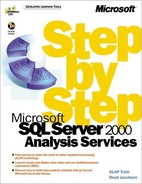Chapter Summary
| To | Do this |
|---|---|
| Allow all network users to see the contents of a cube | Right-click the cube, and click Manage Roles. Click New, type a name for the role, and click Add. Select the Every one group, click Add, and then click OK twice. |
| Duplicate an existing role | Right-click the Database Roles folder, and click Manage Roles. Select a role and click Duplicate. Type a name for the new role, and click OK. |
| Change which cubes are assigned to a role | Select a role, and click the ellipsis button in the Cubes & Mining Models column. To the left of each cube name, select the check box to apply the role to that cube or clear the check box to remove the role from the cube. |
| To restrict access to a dimension of a cube | Right-click the cube, and click Manage Roles. Select a role, and click the ellipsis button in the Restricted Dimensions column. Select a dimension, and in the Rule column, select Fully Restricted from the drop-down list. |
| Restrict access to specific members of a dimension | After selecting a dimension in the Edit A Database Role dialog box, select the Custom option from the Rule drop-down list. Then click the ellipsis button in the Custom column, and select the appropriate members of the dimension. |
| See how a cube would appear if you were logged in as a member of a specific group | Right-click the cube, and click Manage Roles. Select a role and click Test Role. |
| Add cell-level security to a cube | Right-click the cube, and click Manage Roles. Select a role, and click the ellipsis button in the Cells column. Select Advanced from the Cell Security Policy drop-down list. Select Custom in the Rule column, and click the ellipsis in the Custom Settings column. In the MDX box, enter an expression that returns a 1 or 0 for each cell in the cube. |
..................Content has been hidden....................
You can't read the all page of ebook, please click here login for view all page.
